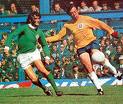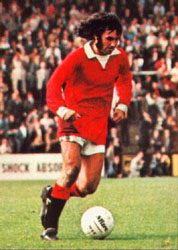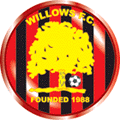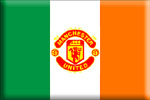George Best – Irish Football Great George Best George BestNorthern Ireland V England George Best – Simply the BestPerhaps the word ‘genius’ is used a bit too liberally when we talk about soccer players today but surely there are few that would argue against using genius to describe George Best on a football pitch. Best was the greatest footballer that the island of Ireland has ever produced. But for his drinking problems he may very well have gone on to challenge the likes of Pele and Maradonna for the claim to be the greatest footballer ever. His well documented problems with alcoholism shortened his topflight sfootball career at the age of 27 when most players are only reaching their peak. Notwithstanding that he managed 466 appearances for Manchester United where he played the best football of his life. Best BoyGeorge Best was born on the 22 May 1946 in Belfast, Northern Ireland. George loved soccer from a very early age and played for his local club in Cregagh. Unbelievably Glentoran FC passed up the opportunity to sign Best because he was deemed to be too small and weak. At the age of 15 he was spotted by Manchester United’s Irish soccer scout Bob Bishop. Perhaps Bishop was the first person to refer to George Best as a genius when he sent a telegram to the then United manager, Matt Busby, with the words “I think I’ve found you a genius”. In July 1961 George and Eric McMordie traveled by boat and train to Manchester for a trial with United. Joe Armstrong was the chief scout at the time and he signed Best up but McMordie didn’t make the cut. He subsequently signed for Middlesboro and later starred with George for the Northern Ireland soccer team. George Best – The Manchester United DaysAfter some initial problems in settling down in Manchester due to homesickness George knuckled down and made rapid progress. He made his Manchester United debut at the age of 17 against West Bromwich Albion FC in Old Trafford in front of 54,000 roaring soccer fans. He scored his first goal for United in his next match against Burnley. In the following season (1964-65) Man Utd won the First Division (now Premier League) title. Over the next few years success on the soccer pitch continued and the world began to take notice of the dazzling Irish footballer with the long hair and good looks. Following a stunning performance against Benfica in Portugal the Portuguese press referred to him as “El Beetle”. He then became known as the fifth beetle. This signified the beginning of the cult of George Best, the off-pitch celebrity. On the football pitch he was playing dream football alongside soccer greats such as Bobby Charlton and Denis Law. Off the pitch he was dating beautiful actresses, modeling clothes and being seen in trendy night clubs. While Best seemed to be living out the dreams of most young men the pressures were building. Drinking helped him to cope with the strain. In 1968 George Best and Manchester United reached their peak by finally winning the European Cup final against Benfica at Wembley Stadium. It was the first time that an English soccer team won the trophy and the young gifted Irish footballer from Belfast got the first goal in extra time to break the Benfica resistance. It was an extravagant goal with Best nutmegging the centre-half. United went on to score two more goals winning by a 4-1 scoreline. George was 22 years of age at the time and he went on to win personal honours later that year, winning the European Footballer of the Year Award and the Football Writers’ Association Player of the Year. This marked the high point for George Best’s soccer career. Increasingly his off-field activities impinged upon his abilities on the football pitch. George Best represented the embodiment of the swinging sixties and he embraced all that went with that. He opened retail fashion units with a Manchester City footballer (Mike Summerbee) and a couple of night clubs. He was constantly seen with other celebrities and beautiful girlfriends and all the while he was drinking to excess. Obviously something had to give and sadly for soccer fans everywhere his football career took the hit. Along with Best, Manchester United went into decline ultimately being relegated to the old Second Division within six years of that European Cup victory. By his own admission George stooped enjoying his football and began to miss training sessions due to the excesses of his nightlife. He walked out on the club on a number of occasions and finally quit the club in January 1974. After 466 appearances, 178 goals, two First Division winners medals, and a European Cup winners Medal, George Best ended his Manchester United career at the age of 27. Second Best ClubsOver the next ten years George Best played for eleven different clubs including two Irish football clubs. The following is the list of clubs in chronological order with the number of appearances:
George Best – Northern Ireland Career George Best played for the Northern Ireland international soccer team on 37 occasions. He scored nine goals against six different teams, Albania, Cyprus, England, Scotland, Switzerland and Turkey. Best is remembered for the goal that never was, against England in Belfast. As Gordon Banks, the English goalkeeper, tossed the football in the air to kick it up the pitch George got his foot to the ball before Banks and hooked it into the air and towards the goal. Best won the foot race and headed the ball into the empty net. The referee disallowed the goal for ungentlemanly conduct. One of Best’s greatest performances for the Northern Ireland soccer team was in 1967 when he practically beat Scotland by himself. It is still remembered as the ‘The George Best International’ match. George Best – Life Without FootballAs it was during his playing career, George Best’s life after he quit playing soccer was beset by problems caused by his alcoholism. He frequently went on binges that sometimes lasted months at a time. There have been allegations that he was violent with some of his female partners and he was jailed for three months in 1984 for assault on a policeman. Best had also been banned from driving after being convicted of drunk-driving. During his appearance on the Wogan TV show in 1990 he was obviously drunk and later apologised for the use of expletives during the interview. Best’s drinking caused him a number of health problems over the years. In 2002 he underwent a successful liver transplant. Amid some public outcry George returned to his old drinking habits and in 2005 he was admitted to hospital with a renal infection. The infection was caused by the immuno-suppresant drugs used to prevent rejection of the transplanted liver. On 25 November 2005 George Best died in London due to further medical complications and multiple organ failure. He was surrounded by friends and family when he died at the age of 59. The great George Best was buried in his native Belfast in Ireland where over one hundred thousand people lined the funeral procession route to mourn the passing of a true Irish soccer great. In his own words: “At the end of the day, no matter what I’ve done, it’s the football that they remember” George Best – Manchester United & Northern Ireland Statistics |
 |
|
References :Blessed: The Autobiography; George Best (2002); Ebury Press Irish Devils – The Official Story of Manchester United and the Irish
|
Irish Football Players – All Republic of Ireland FootballersJohn Aldridge – George Best – Packie Bonner – Liam Brady – Shay Brennan – Noel Cantwell – Johnny Carey – Gerry Daly – Mal Donaghy – Derek Dougan – Damien Duff – Tony Dunne – Eamon Dunphy – Johnny Giles |
|
Republic of Ireland Football Managers – Irish Manager’s Records Mick Meagan – Liam Tuohy – Sean Thomas – John Giles – Alan Kelly – Eoin Hand – Jack Charlton |
| Manchester United – Irish Man Utd Players |
| George Best – Jonny Evans – John Giles – Roy Keane – Paul McGrath – Patrick O’Connell – Liam Whelan |






